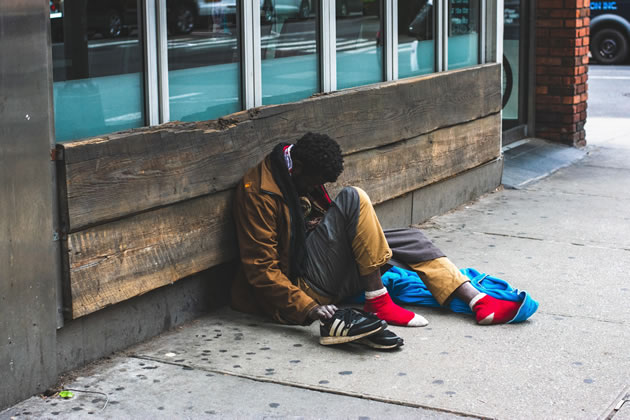Hounslow Braces For Emergency Housing Demand Surge
Council launches its second action plan on homelessness in the borough

Picture: Malcolm Garret/Pexels
A report presented to Hounslow Council this week provided a stark warning for the challenges ahead for housing policy in the borough.
Hounslow Council has approved its second Homelessness Reduction Action Plan 2019/24 whicn sets out a package of measures to tackle and prevent homelessness in Hounslow.
The council has managed to cut the amount it pays to private landlords for temporary accommodation by two-thirds. Since the 2016/17 financial year the council has reduced payments to landlords to house those at risk of becoming homeless from £1.59 million to just under £440,000.
However, with 1623 households currently on the housing waiting list, cuts expected in government grants, and demand for housing services predicted to increase over the next four years, the environment looks set to be tougher.
The report to Cabinet notes the number of people approaching the Housing Service has doubled from less than 300 in March 2018, to over 600 in March this year.
This figure is expected to increase further, while the ending of central government grant funding from April 2020 is anticipated to create a potential budget deficit of approximately £2.7m.
As a result, the report advises: "“In order to maintain the past successes of the service we consider that there is a need to review expectations and budgets.”"
Hounslow’s spending on private temporary accommodation for residents at risk of homelessness is far lower than neighbouring borough Ealing, which paid landlords £37 million last year.
The Cabinet report puts this saving down to the council’s Homelessness Action Plan, which focuses on three broad objectives: preventing homelessness; increasing housing supply, and reducing temporary accommodation spending.
The council reported an increase in the number of people it prevented becoming homeless from 295 in 2015/16 to 380 in 2017/18.
The report notes: “This includes negotiating hard with private landlords and family members to stave off evictions, which combined account for up to 70% of people seeking housing assistance from the council.”
Council also pointed to 694 new Council and Housing Association homes built between 2015-18 as helping reduce spending.
There were also 247 under-occupied family-sized homes released for re-letting in this period.
Other savings were made in the downsizing of 81 tenants from family-sized homes into smaller accommodation between April 2017 and March 2018; and a reduced use of expensive Bed and Breakfast accommodation.
A Freedom of Information Act request revealed 13725 households are currently in council owned properties in Hounslow, with an additional 643 households in temporary accommodation.
Hounslow Council is succeeding with keeping most temporary accommodation users close by, with 97% being housed in the borough, and the remainder in neighbouring boroughs.
The time households usually spent in temporary accommodation is also lower than neighbouring Ealing, with the average sitting at 15 months and 11 days. In Ealing this figure sits at four and a half years.
Despite the strong showing, Conservative Group Leader Joanna Biddolph said the figures didn’t deal with the appropriateness of the accommodation or the supply of appropriate accommodation.
She said: “Too many people are currently living in properties far bigger than they need. “At the same time, families are squeezed into flats that are too small for them.”
Ms Biddolph said the council was building blocks of smaller flats when the need was for larger family sized homes.
She said: “If Hounslow is performing better than other authorities, that is good news. However, comparing local authorities only brings small comfort to residents seeking the right homes.
“To many people who are living in inappropriate accommodation, any wait is too long.”
Other savings were made in the downsizing of 81 tenants from family-sized homes into smaller accommodation between April 2017 and March 2018; and a reduced use of expensive Bed and Breakfast accommodation.
Over the past five years, the council has successfully reduced the number of households living in temporary accommodation (TA). In 2014, there were over 1,140 households living in TA, reduced by 40 per cent to 675 households at the end of March 2019.
A statement from Hounslow Council said: " Despite the increasing
pressures and demand for services added by the Homelessness Reduction
Act 2017, Hounslow is reaping benefits and seeing a reduction in the use
of Bed and Breakfast, temporary accommodation and numbers of people sleeping
rough on the streets."
Councillor Steve Curran, Leader of Hounslow Council, said: “People's
perception of homelessness is often focused on the people who are literally
on the streets. But it's something much wider than that. With austerity
continuing and financial uncertainty, our housing services are facing
unprecedented pressures, with demand for both permanent and temporary
accommodation exceeding supply. However, this council is determined to
continue to help the most vulnerable in our borough, which is why we have
been focusing our efforts on tackling homelessness and rough sleeping.
"Our comprehensive Homelessness Action Plan 2019/24 shows exactly
how we can address the root causes of homelessness and work to make it
a thing of the past. We are bold and ambitious for our residents and will
not simply accept homelessness as a sad fact of life because we know it
doesn’t have to be this way. I look forward to working with all
our partners and communities who are also key players in helping us to
prevent and reduce homelessness in our borough.”
Read the full cabinet report here.
Written with contributions from Ged Cann – Local Democracy Reporter
June 13, 2019